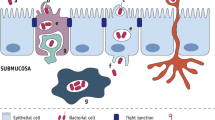Abstract
Gram-negative bacterium Serratia marcescens is a well-known environmental microorganism and the accepted clinical pathogen causing nosocomial infections. It attracts more attention in recent years due to the emergence of strains with multiple drug resistance. Standard recombinant techniques are difficult to apply to S. marcescens due to the presence of numerous hydrolytic enzymes, in particular, extracellular nuclease and restriction endonuclease, which degrade transforming DNAs. We overcame this obstacle by utilizing restrictionless nuclease-deficient mutant strain S. marcescens TT392. As a proof of principal, in this genetic background, we generated a knockout strain with deletion of macAB locus using lambda red technology. The resulting mutation could be easily moved to a new genetic background by generalized phage transduction. This strategy provides a good tool for evaluation of S. marcescens pathogenic potential.

Similar content being viewed by others
References
Mahlen, S. D. (2011). Serratia infections: from military experiments to current practice. Clinical Microbiology Reviews, 24(4), 755–791. doi:10.1128/CMR.00017-11.
Benedik, M. J., & Strych, U. (1998). Serratia marcescens and its extracellular nuclease. FEMS Microbiology Letters, 165(1), 1–13.
Datsenko, K. A., & Wanner, B. L. (2000). One-step inactivation of chromosomal genes in Escherichia coli K-12 using PCR products. Proceedings of the National Academy of Sciences of the United States of America, 97(12), 6640–6645. doi:10.1073/pnas.120163297.
Porwollik, S., Santiviago, C. A., Cheng, P., Long, F., Desai, P., Fredlund, J., Srikumar, S., Silva, CA., Chu, W., Chen, X., Canals, R., Reynolds, M. M., Bogomolnaya, L., Shields, C., Cui, P., Guo, J., Zheng, Y., Endicott-Yazdani, T., Yang, H. J., Maple, A., Ragoza, Y., Blondel, C. J., Valenzuela, C., Andrews-Polymenis, H., McClelland, M. (2014). Defined single-gene and multi-gene deletion mutant collections in Salmonella enterica sv Typhimurium. PloS One, 9(7), e99820. doi:10.1371/journal.pone.0099820.
Santiviago, C. A., Reynolds, M. M., Porwollik, S., Choi, S. H., Long, F., Andrews-Polymenis, H. L., McClelland, M. (2009). Analysis of pools of targeted Salmonella deletion mutants identifies novel genes affecting fitness during competitive infection in mice. PLoS Pathogens, 5(7), e1000477. doi:10.1371/journal.ppat.1000477.
Reid, J. D., Stoufer, S. D., Ogrydziak, D. M. (1982). Efficient transformation of Serratia marcescens with pBR322 plasmid DNA. Gene, 17(1), 107–112.
Takagi, T., & Kisumi, M. (1985). Isolation of a versatile Serratia marcescens mutant as a host and molecular cloning of the aspartase gene. Journal of Bacteriology, 161(1), 1–6.
Palomar, J., Guasch, J. F., Regue, M., Vinas, M. (1990). The effect of nuclease on transformation efficiency in Serratia marcescens. FEMS Microbiology Letters, 57(3), 255–258.
Palomar, J., & Vinas, M. (1996). The effect of O-antigen on transformation efficiency in Serratia marcescens. Microbiología, 12(3), 435–438.
Wang, R. F., & Kushner, S. R. (1991). Construction of versatile low-copy-number vectors for cloning, sequencing and gene expression in Escherichia coli. Gene, 100, 195–199.
Swords, W. E. (2003). Chemical transformation of E. coli. Methods in Molecular Biology, 235, 49–53. doi:10.1385/1-59259-409-3:49.
Rossi, M. S., Paquelin, A., Ghigo, J. M., Wandersman, C. (2003). Haemophore-mediated signal transduction across the bacterial cell envelope in Serratia marcescens: the inducer and the transported substrate are different molecules. Molecular Microbiology, 48(6), 1467–1480.
Acknowledgments
This work was supported in part by a subsidy to support the program of competitive growth of Kazan Federal University and Russian Science Foundation project 16-14-10200 (L.K., T.S., and L.B.).
Author information
Authors and Affiliations
Corresponding author
Rights and permissions
About this article
Cite this article
Kamaletdinova, L.K., Nizamutdinova, E.K., Shirshikova, T.V. et al. Inactivation of Chromosomal Genes in Serratia marcescens . BioNanoSci. 6, 376–378 (2016). https://doi.org/10.1007/s12668-016-0249-2
Published:
Issue Date:
DOI: https://doi.org/10.1007/s12668-016-0249-2




